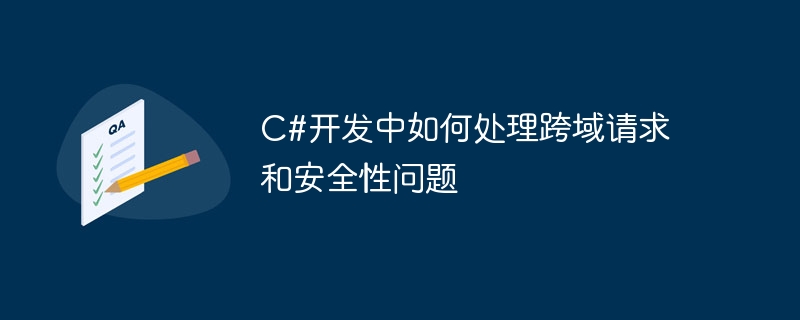 Backend Development
Backend Development
 C#.Net Tutorial
C#.Net Tutorial
 How to handle cross-domain requests and security issues in C# development
How to handle cross-domain requests and security issues in C# development
How to handle cross-domain requests and security issues in C# development

How to handle cross-domain requests and security issues in C# development
在现代的网络应用开发中,跨域请求和安全性问题是开发人员经常面临的挑战。为了提供更好的用户体验和功能,应用程序经常需要与其他域或服务器进行交互。然而,浏览器的同源策略导致了这些跨域请求被阻止,因此需要采取一些措施来处理跨域请求。同时,为了保证数据的安全性,开发人员还需要考虑一些安全性问题。本文将探讨How to handle cross-domain requests and security issues in C# development,并提供一些具体的代码示例。
一、跨域请求处理
跨域请求是指在一个域下向另一个域发送请求。在C#开发中,处理跨域请求可以通过以下几种方式:
- 跨域资源共享(CORS)
CORS是一种机制,它允许服务器在响应中添加一些HTTP头部,从而告诉浏览器该服务器支持哪些跨域请求。要在C#中启用CORS,可以通过在Web.config文件中或者在Global.asax文件中添加以下代码:
protected void Application_BeginRequest(object sender, EventArgs e)
{
HttpContext.Current.Response.AddHeader("Access-Control-Allow-Origin", "*");
HttpContext.Current.Response.AddHeader("Access-Control-Allow-Methods", "GET, POST, OPTIONS");
HttpContext.Current.Response.AddHeader("Access-Control-Allow-Headers", "Content-Type, Authorization");
HttpContext.Current.Response.AddHeader("Access-Control-Allow-Credentials", "true");
}这段代码将允许任何来源的请求,并支持GET、POST、OPTIONS方法。
- 代理服务器
另一种处理跨域请求的方式是使用代理服务器。开发人员可以在自己的服务器上创建一个代理,将跨域请求的数据转发到目标服务器,并将响应返回给客户端。以下是一个简单的代理服务器的示例代码:
public async Task ProxyRequestAsync(string url, HttpContext context)
{
using (HttpClient client = new HttpClient())
{
HttpRequestMessage request = new HttpRequestMessage();
request.Method = new HttpMethod(context.Request.Method);
request.RequestUri = new Uri(url);
foreach (var header in context.Request.Headers)
{
request.Headers.Add(header.Key, header.Value.ToArray());
}
if (context.Request.Method == "POST")
{
using (Stream stream = await context.Request.Body.ReadAsync())
{
request.Content = new StreamContent(stream);
request.Content.Headers.ContentType = new MediaTypeHeaderValue(context.Request.ContentType);
}
}
HttpResponseMessage response = await client.SendAsync(request);
foreach (var header in response.Headers)
{
context.Response.Headers.Add(header.Key, header.Value.ToArray());
}
context.Response.StatusCode = (int)response.StatusCode;
using (Stream content = await response.Content.ReadAsStreamAsync())
{
await content.CopyToAsync(context.Response.Body);
}
}
}使用此代理服务器,可以将跨域请求的URL作为参数传递给ProxyRequestAsync方法,然后在控制器或处理程序中调用此方法来处理请求。
二、安全性问题处理
除了处理跨域请求外,C#开发人员还需要关注应用程序的安全性。以下是一些常见的安全性问题以及如何在C#开发中解决它们的示例代码:
- 跨站脚本攻击(XSS)
XSS攻击是通过插入恶意脚本来获取用户的敏感信息或攻击网站。为了防止XSS攻击,可以对用户输入进行验证和过滤,并使用HTML编码对输出进行处理。以下是一个示例代码:
string userInput = "<script>alert('XSS');</script>";
string safeOutput = HttpUtility.HtmlEncode(userInput);
Console.WriteLine(safeOutput); // 输出的值为<script>alert('XSS');</script>使用HttpUtility.HtmlEncode可以对用户输入进行编码,从而防止插入恶意脚本。
- 跨站请求伪造(CSRF)
CSRF攻击是利用用户的身份进行非法操作,如发送恶意请求或更改帐户设置。为了防止CSRF攻击,可以在每个请求中包含一个安全的令牌,然后在服务器端进行验证。以下是一个示例代码:
string token = GenerateToken();
string requestUrl = "https://example.com?token=" + token;
// 将token存储在Session或Cookie中,以便在验证时使用
// 在处理请求时,从Session或Cookie中获取token,并验证
string requestToken = context.Request.Query["token"];
if (requestToken != token)
{
throw new Exception("CSRF Attack Detected!");
}在生成令牌时,可以使用Guid.NewGuid()来生成唯一的令牌,然后将其存储在Session或Cookie中。在验证时,比较请求中的令牌和存储的令牌是否一致。
总结
本文介绍了在C#开发中处理跨域请求和安全性问题的方法,并提供了一些具体的代码示例。通过合理地处理跨域请求和提高应用程序的安全性,可以提供更好的用户体验和保护用户的敏感信息。在实际开发中,开发人员还应根据应用程序的需求和实际情况,采取适当的安全措施。
The above is the detailed content of How to handle cross-domain requests and security issues in C# development. For more information, please follow other related articles on the PHP Chinese website!

Hot AI Tools

Undresser.AI Undress
AI-powered app for creating realistic nude photos

AI Clothes Remover
Online AI tool for removing clothes from photos.

Undress AI Tool
Undress images for free

Clothoff.io
AI clothes remover

AI Hentai Generator
Generate AI Hentai for free.

Hot Article

Hot Tools

Notepad++7.3.1
Easy-to-use and free code editor

SublimeText3 Chinese version
Chinese version, very easy to use

Zend Studio 13.0.1
Powerful PHP integrated development environment

Dreamweaver CS6
Visual web development tools

SublimeText3 Mac version
God-level code editing software (SublimeText3)

Hot Topics
 Active Directory with C#
Sep 03, 2024 pm 03:33 PM
Active Directory with C#
Sep 03, 2024 pm 03:33 PM
Guide to Active Directory with C#. Here we discuss the introduction and how Active Directory works in C# along with the syntax and example.
 Access Modifiers in C#
Sep 03, 2024 pm 03:24 PM
Access Modifiers in C#
Sep 03, 2024 pm 03:24 PM
Guide to the Access Modifiers in C#. We have discussed the Introduction Types of Access Modifiers in C# along with examples and outputs.
 Random Number Generator in C#
Sep 03, 2024 pm 03:34 PM
Random Number Generator in C#
Sep 03, 2024 pm 03:34 PM
Guide to Random Number Generator in C#. Here we discuss how Random Number Generator work, concept of pseudo-random and secure numbers.
 C# Data Grid View
Sep 03, 2024 pm 03:32 PM
C# Data Grid View
Sep 03, 2024 pm 03:32 PM
Guide to C# Data Grid View. Here we discuss the examples of how a data grid view can be loaded and exported from the SQL database or an excel file.
 Patterns in C#
Sep 03, 2024 pm 03:33 PM
Patterns in C#
Sep 03, 2024 pm 03:33 PM
Guide to Patterns in C#. Here we discuss the introduction and top 3 types of Patterns in C# along with its examples and code implementation.
 C# Serialization
Sep 03, 2024 pm 03:30 PM
C# Serialization
Sep 03, 2024 pm 03:30 PM
Guide to C# Serialization. Here we discuss the introduction, steps of C# serialization object, working, and example respectively.
 Prime Numbers in C#
Sep 03, 2024 pm 03:35 PM
Prime Numbers in C#
Sep 03, 2024 pm 03:35 PM
Guide to Prime Numbers in C#. Here we discuss the introduction and examples of prime numbers in c# along with code implementation.
 Web Services in C#
Sep 03, 2024 pm 03:32 PM
Web Services in C#
Sep 03, 2024 pm 03:32 PM
Guide to Web Services in C#. Here we discuss an introduction to Web Services in C# with technology use, limitation, and examples.





